
1910-1915 NYC: Rise of The Skyscraper & Impact of Social Change on The City
The period between 1910 and 1915 in New York City was distinguished by an architectural revolution, notably marked by the rise of the skyscraper. The completion of the Woolworth Building in 1913, reaching a then-unprecedented height of 792 feet, stood as a landmark event. This Gothic-style skyscraper reshaped the city’s skyline and symbolized the aspirations and economic prowess of New York City. It was during these years that the city truly began to assume its modern form, with towering structures increasingly dominating the landscape.
Concurrent with the architectural boom, significant strides were made in expanding the city’s infrastructure. The New York City subway system, operational since 1904, continued to extend its reach, connecting more neighborhoods and facilitating the growth of the outer boroughs. This era also witnessed advancements in road and bridge construction, notably the early stages of the iconic Manhattan Bridge, thereby enhancing the city’s physical connectivity.
This era also heralded a time of vibrant cultural and social change. The arts flourished, with Broadway emerging as an epicenter for theater and performance. New York City’s diverse population, bolstered by ongoing immigration, contributed to a rich tapestry of cultural expressions, spanning music, art, and literature. Social reform movements gained traction, tackling issues such as women’s suffrage, labor rights, and the welfare of the rapidly growing working class.
Economically, New York City continued to flourish and expand, reinforcing its status as a financial and industrial center. However, this growth came with its own set of challenges. The Panic of 1910-1911, although less severe than the financial crisis of 1907, still impacted the city’s economy. During this time, there was an increased focus on urban challenges, including housing shortages and the need for improved public services, underscoring the complexities associated with rapid urban development.
Timeline of New York City’s History 1910-1915
Discover surprising historical facts about The City That Never Sleeps—explore fun, educational insights into its history, population, iconic landmarks, and more, perfect for students, history enthusiasts, and anyone curious about NYC’s rich heritage.
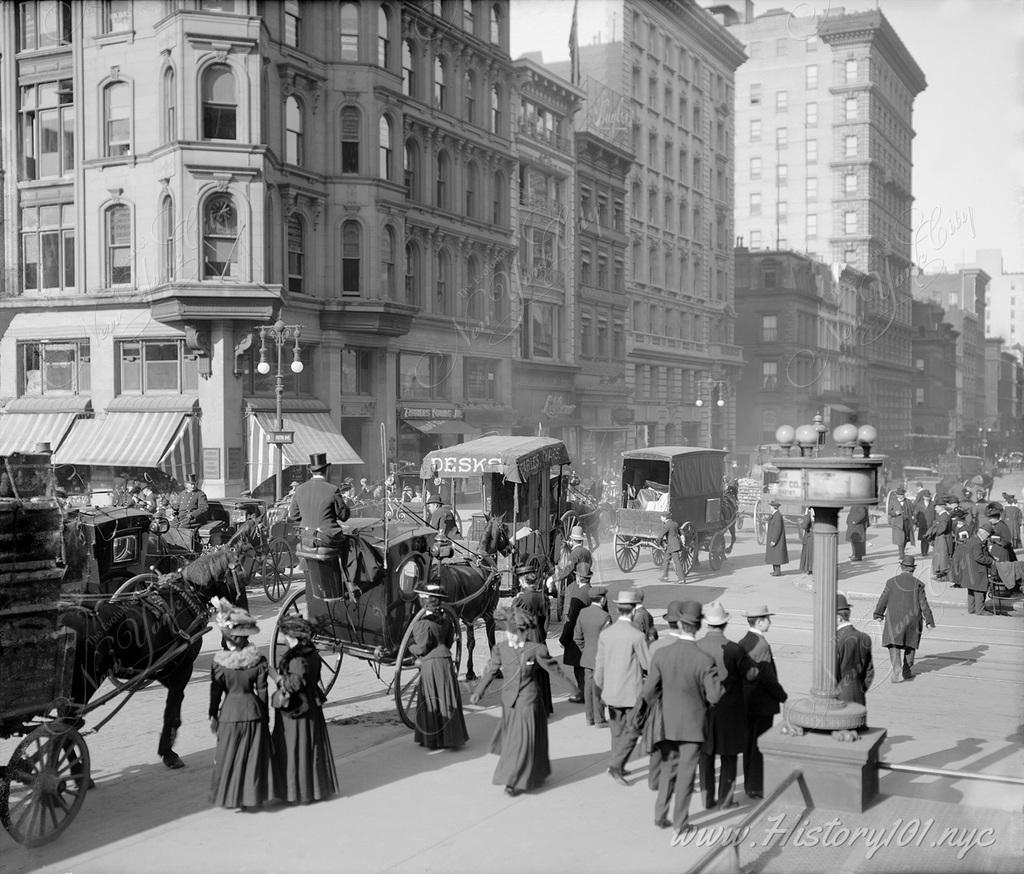
1910: Pedestrians on 42nd Street and 5th Avenue
One of the city's busiest intersections filled with shoppers, commuters. The streets are packed with horses and carriages.
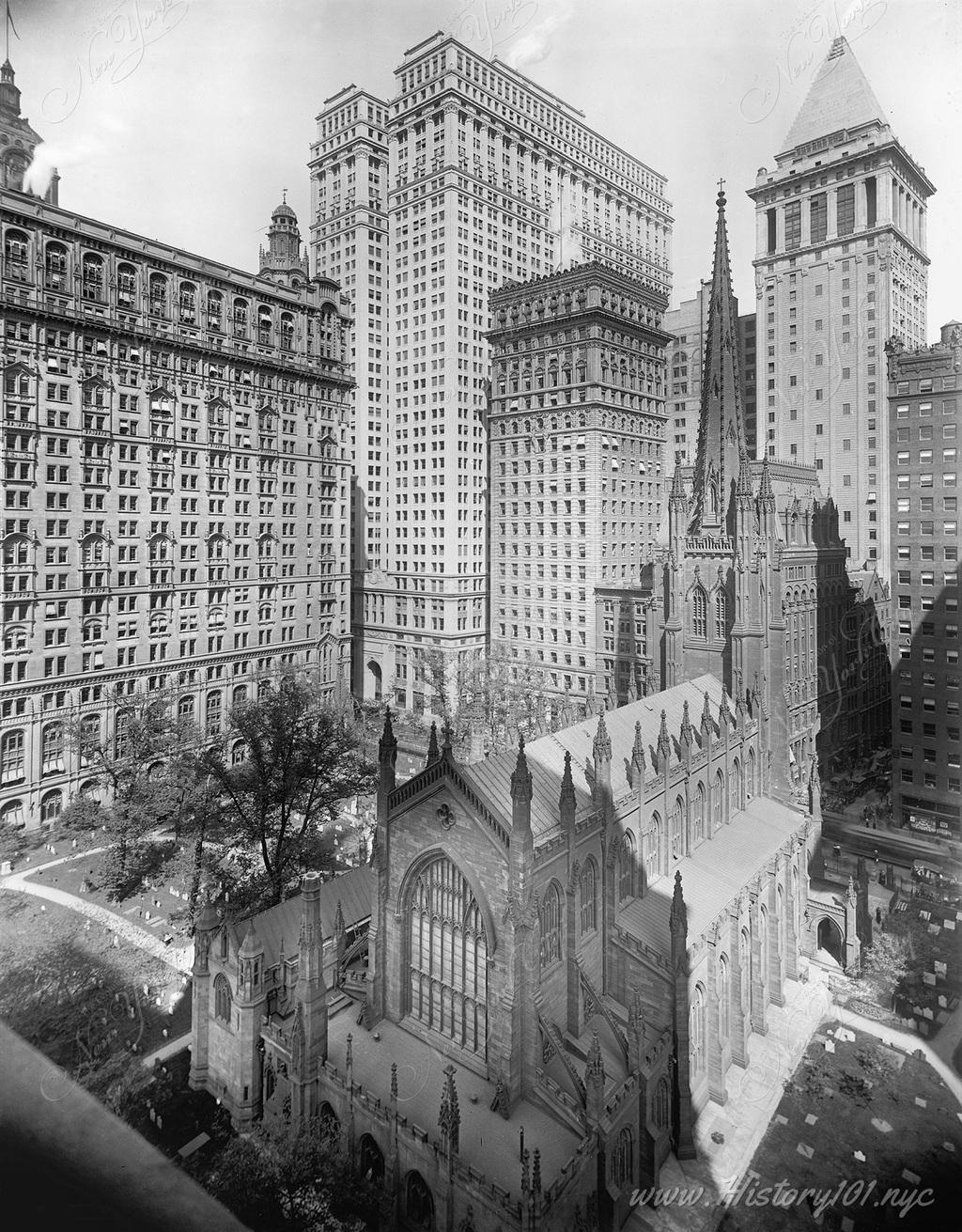
1910: Panoramic View of Trinity Church
Photograph of an elevated perspective of Trinity Church and its surrounding buildings.

1910: Aerial View of Grand Central Terminal
A bird's eye view of midtown Manhattan featuring the recently completed Grant Central Terminal.
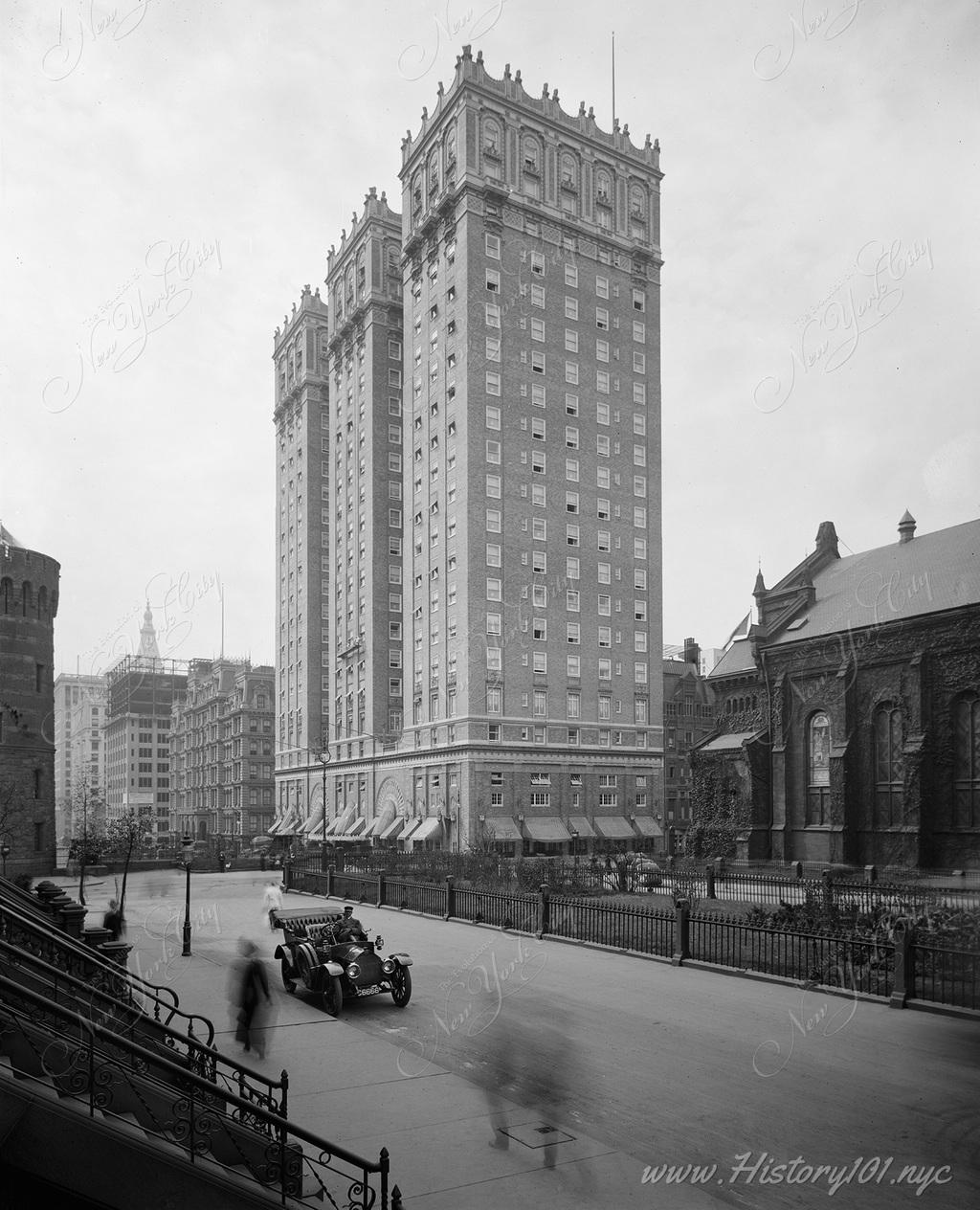
1913: The Vanderbilt Hotel: A Window into Early 20th-Century NYC Elegance
Discover the Vanderbilt Hotel, a 1913 NYC landmark, showcasing the city's architectural grandeur and cultural ascent in the early 20th century
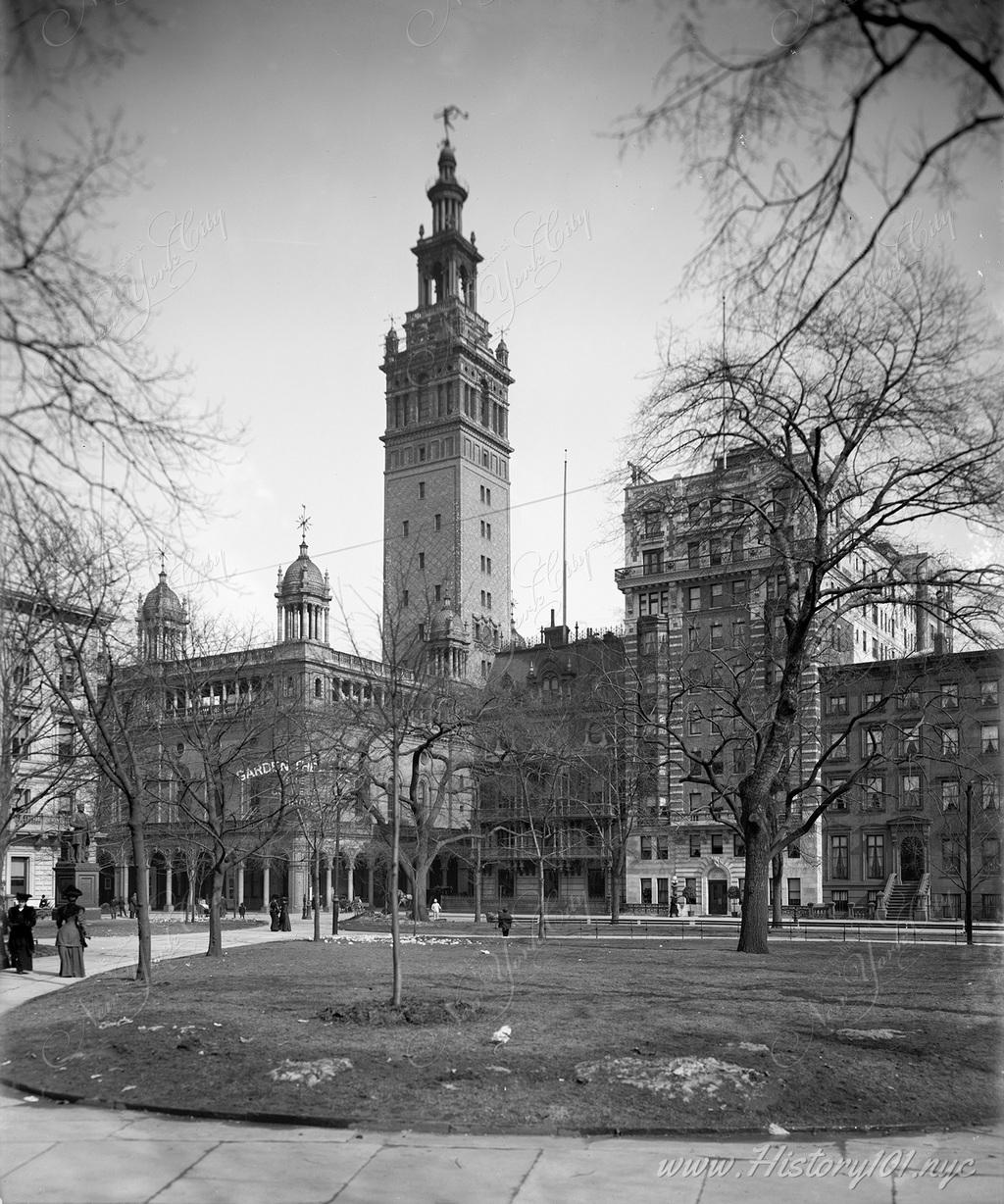
1910: Madison Square Garden: A Glimpse into New York's Cultural Heart
Discover the 1910 Madison Square Garden, a symbol of NYC's architectural and cultural evolution at the heart of Manhattan

1910: Speyer House on 87th Street
Photograph shows the James Speyer house, to the right, a mansion at 1058 Fifth Avenue, on the southeast corner of 87th Street,

1910: Pennsylvania Station from Above
Aerial photograph of the newly completed Pennsylvania Station shows off the elaborate masonry and scale of this highly ambitious building.
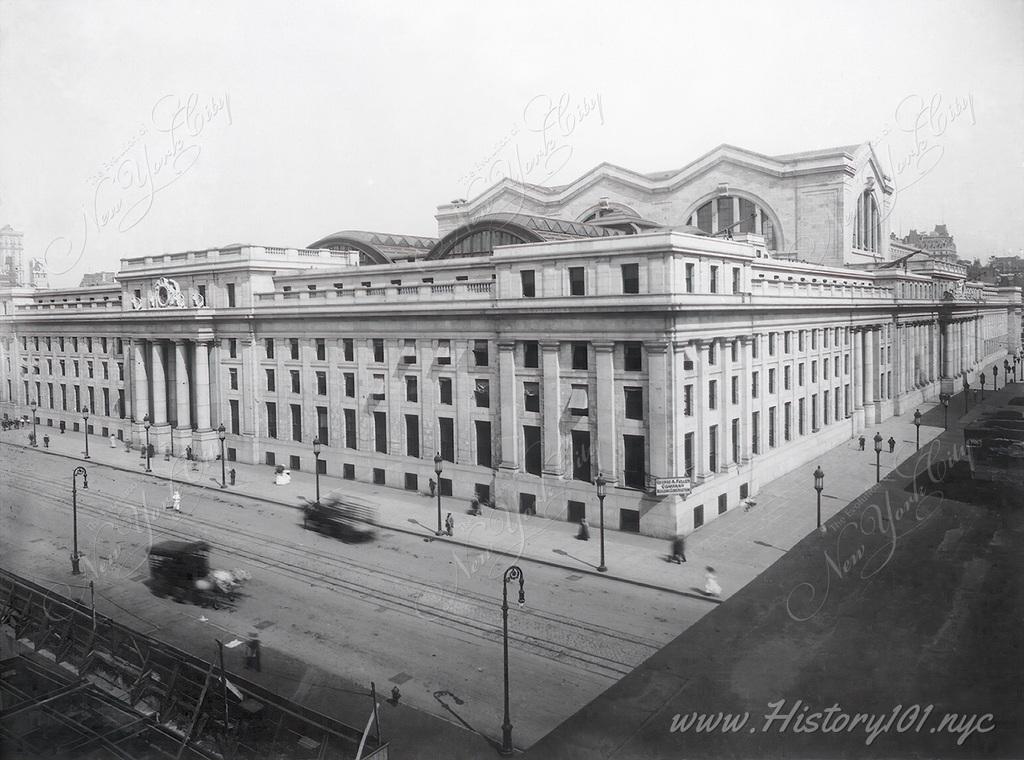
1910: Pennsylvania Railroad Station Exterior Facade
Photograph from an elevated perspective showing 32nd and 33rd Street and 7th Avenue and the facade of Pennsylvania Station as horses and carriages pass by.
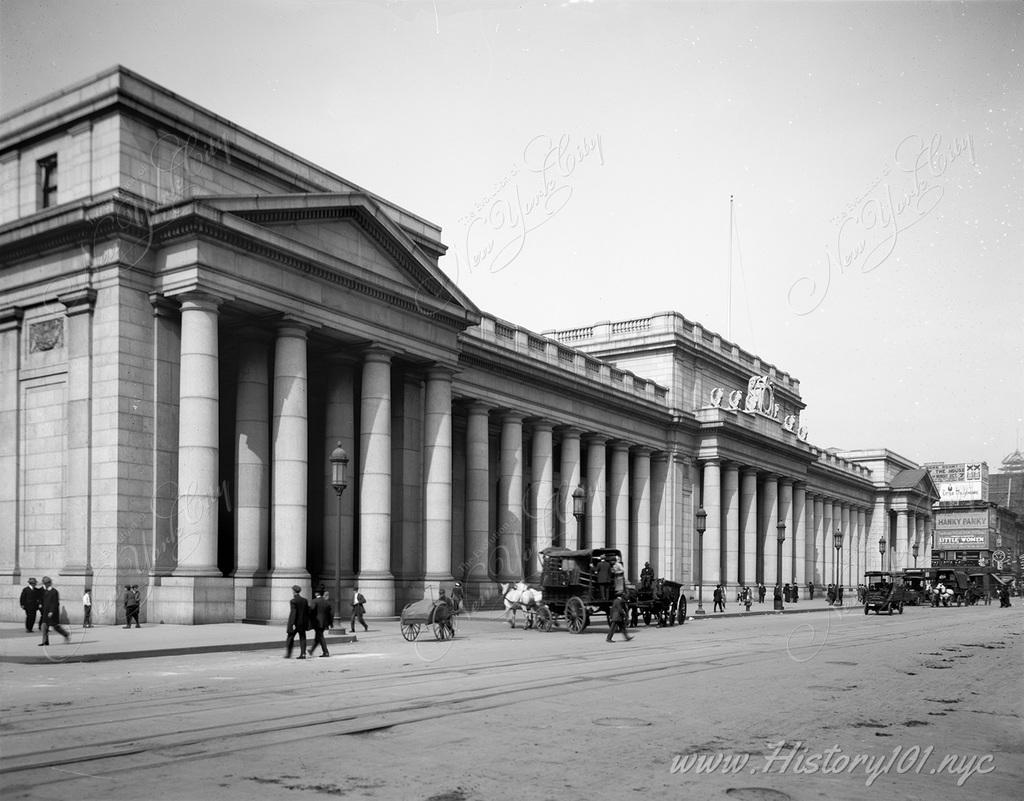
1910: East Facade of Pennsylvania Station
Pedestrians walk in front of the recently completed Penn Station - whose opulence and grand design would make it one of the city's most cherished landmarks.
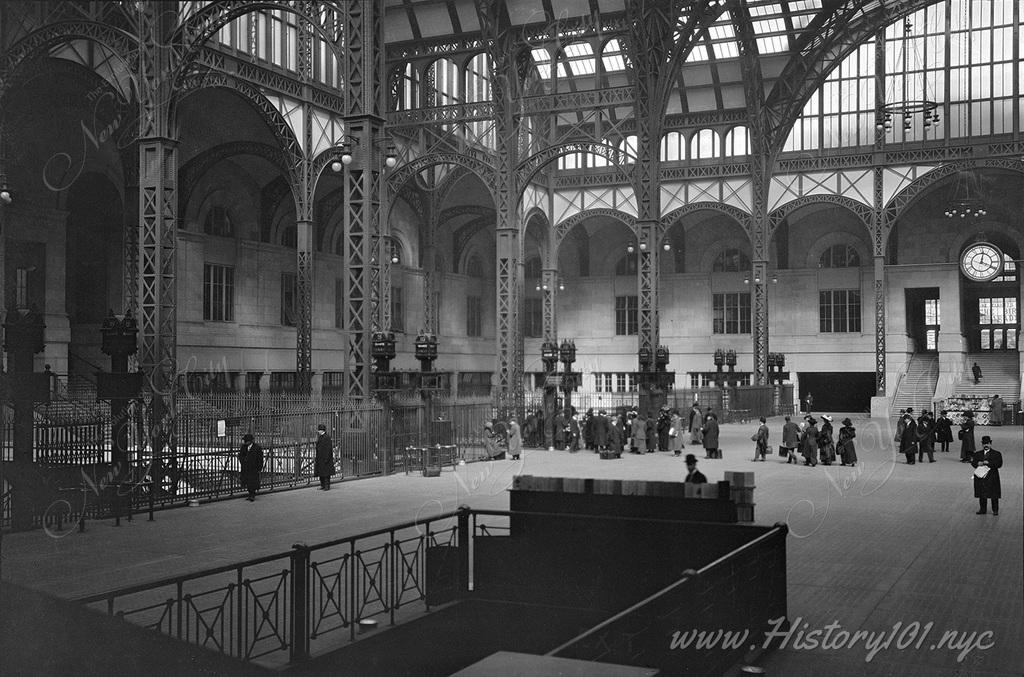
1910: Pennsylvania Station Interior
Photograph of pedestrians commuting at the Pennsylvania Station, where the Long Island Railroad opened to the public on September the 8th, 1910.
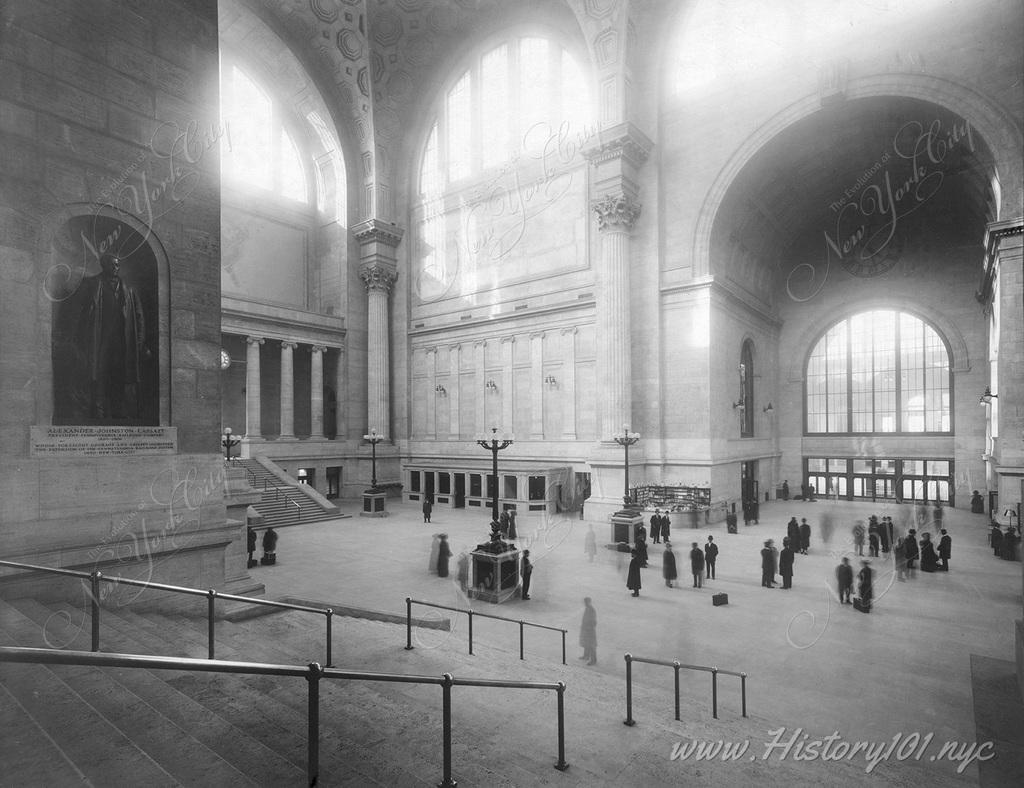
1911: Waiting Room at Pennsylvania Station
Passengers in the waiting room at Pennsylvania Station, with statue of Alexander Johnston Cassatt, president of the Pennsylvania Railroad Company.
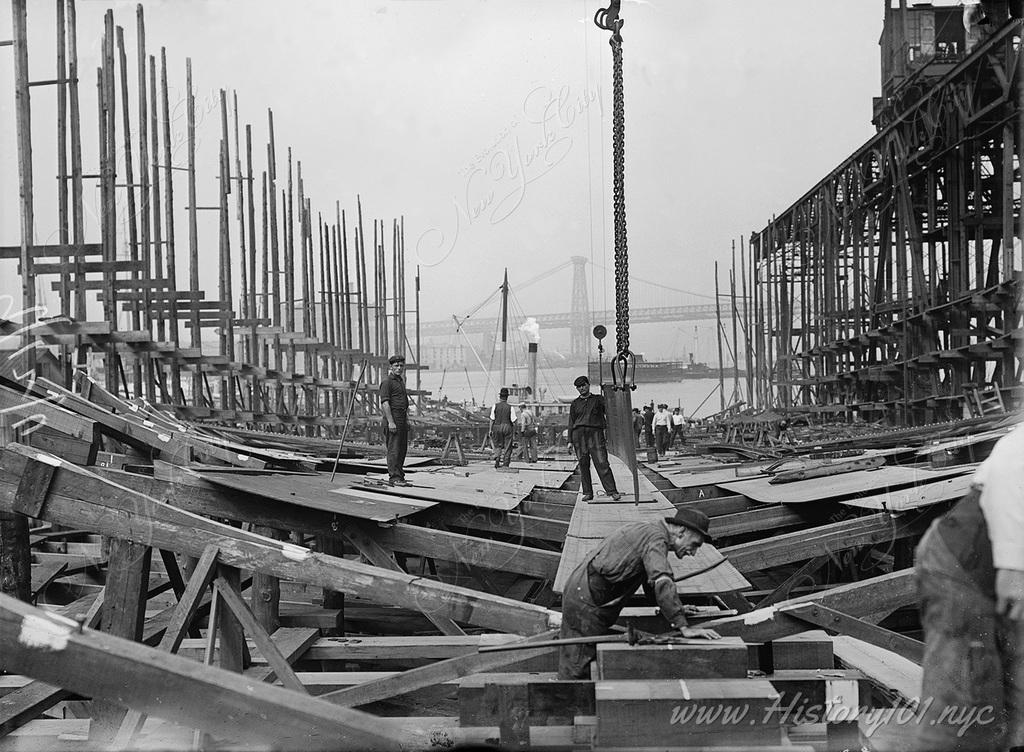
1910: Keel of New York, Brooklyn Navy Yard,
Photograph of construction workers at the Brooklyn Navy Yard building a large timber framed ship from the keel up.
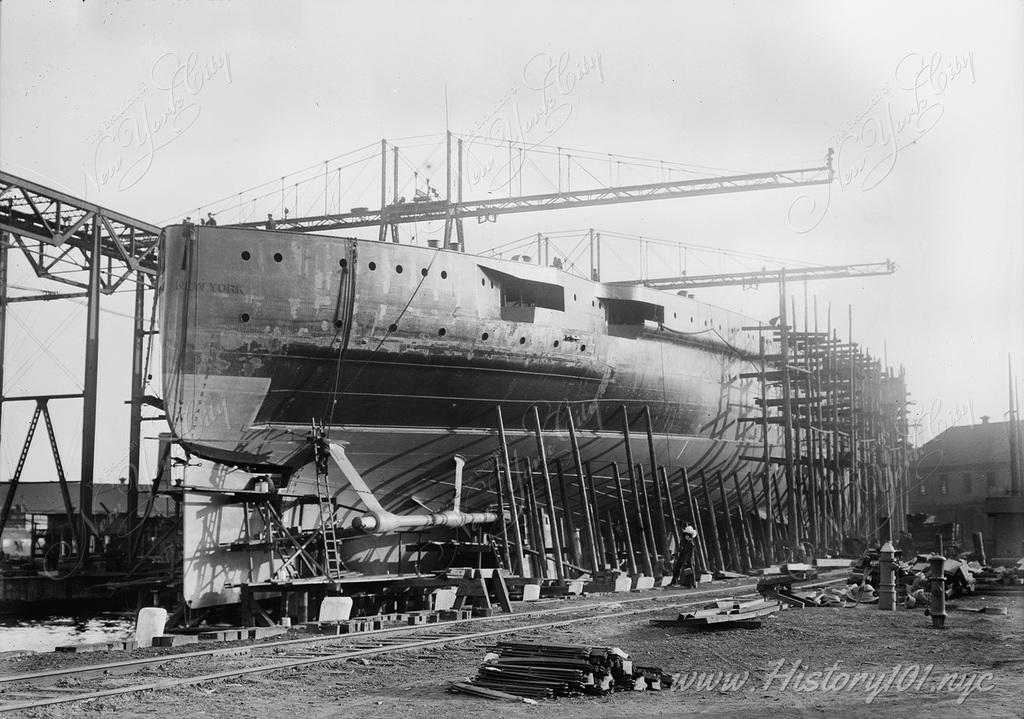
1910: Building USS New York at Brooklyn Navy Yard
Photograph showing the construction of the USS New York at Brooklyn Navy Yard.

1910: Shoeshine Stand on 3rd Avenue and 9th Street
Shoeshine stand beneath the Third Avenue elevated train in the East Village
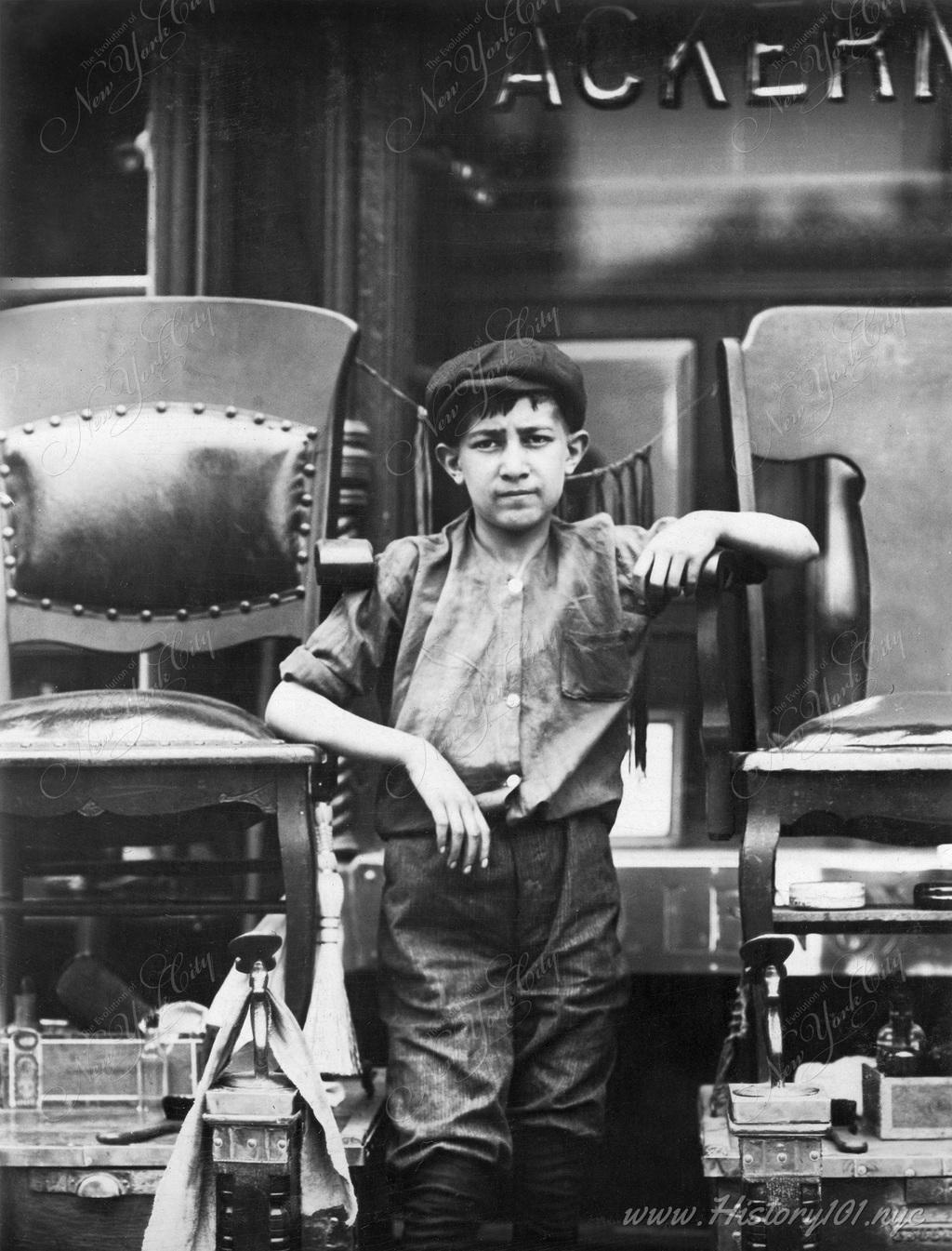
1910: Tending a Shoe Shine Stand on Greenwich Avenue
Photograph of a Frank Villanello, tending his father's shoe shine stand located at 21 Greenwich Avenue
Timeline of New York City: 1910-1915
1910: New York City's total population reached 4,766,883, reflecting the city's status as a melting pot of cultures and a burgeoning hub of economic activity. The 1910 census data breakdown by borough shows distinct population densities and growth that highlight the urban expansion of that era. Manhattan, the most densely populated borough, had a population of 2,331,542, underscoring its central role in commerce and industry. Brooklyn followed with 1,634,351 residents, demonstrating its rapid residential and industrial growth. The Bronx had seen significant growth to 430,980, likely spurred by the expansion of infrastructure such as bridges and public transportation that made it more accessible.
Queens and Staten Island, though more sparsely populated than their counterparts, showed notable increases to 284,041 and 85,969, respectively. These figures indicate the early stages of residential expansion that would become more pronounced in the coming decades as more people moved away from the crowded city center to the outer boroughs. The 1910 census data not only provides a snapshot of New York City's population distribution but also serves as a testament to the city's rapid evolution from a compact urban core to a sprawling metropolis. This demographic expansion played a crucial role in shaping the city's socio-economic structure, influencing everything from urban planning and public transportation to cultural institutions and public services, setting the stage for New York's rise as a global city.
1910: Gimbels Department Store solidified its presence in New York City's retail scene by opening a large store in Herald Square, after being founded by Adam Gimbel in 1887. Situated directly across from Macy's, Gimbels not only challenged its rival but also played a pivotal role in transforming Herald Square into one of the city's premier shopping destinations. This strategic move enhanced the competitive landscape of NYC's retail industry, with Gimbels becoming renowned for its wide range of merchandise and aggressive marketing strategies. The store's establishment in such a prominent location contributed significantly to the development of Midtown Manhattan, boosting both traffic and business in the area.
Beyond its economic impact, Gimbels became a cultural icon in New York City, known for its customer service innovations and festive holiday events, which included the famous Gimbels Thanksgiving Day Parade. Introduced in the early 1920s, the parade became a beloved annual tradition that rivaled Macy's own Thanksgiving parade, adding to the city's festive atmosphere and attracting visitors from across the nation. Although Gimbels closed in 1987, its legacy in shaping the retail and cultural landscape of New York City endures. The store's contribution to establishing Herald Square as a global shopping hub has left an indelible mark on the city's economic and cultural history, reflecting the dynamic and competitive spirit of New York's retail environment.
1910: William J. Gaynor initiated crucial reforms in New York City upon taking office, marking a significant departure from the stagnation of George B. McClellan's tenure. A key move was appointing Charles B. Stover as Manhattan Park Commissioner, a pivotal figure in urban recreation, tasked with expanding the city's playgrounds. Stover's efforts culminated in the creation of the first Bureau of Recreation within the Parks Department, heralding a new era for public recreational facilities.
By 1915, the number of NYC playgrounds had surged from nine to 70 under Stover's direction, reflecting a broader initiative to enhance urban living through accessible recreational spaces. This initiative not only improved the physical health and safety of the city's youth but also fostered community engagement and social well-being. Furthermore, the Parks Department's sponsorship of athletic competitions and leagues significantly enriched NYC's recreational landscape, cementing the city's commitment to nurturing a vibrant, dynamic community.
1911: On February 21, Gustav Mahler conducted his final concert at Carnegie Hall in New York City, leading the New York Philharmonic Orchestra in a program that included the world premiere of Ferruccio Busoni's Berceuse elegiaque. Despite suffering from a severe fever and inflamed throat, Mahler, against his doctor's advice, proceeded with the performance. The concert also featured pianist Ernesto Consolo as a soloist. This appearance marked Mahler’s last time on the conductor's podium; he nearly collapsed during the event and was subsequently forced to cancel all further engagements due to his deteriorating health.
Following his final concert, Mahler's health continued to worsen, prompting him and his wife, Alma, to sail for Europe on April 8, seeking better medical care. Unfortunately, Mahler's condition did not improve, and he passed away from a bacterial infection in Vienna on May 18, at the age of 50. His death left his Tenth Symphony incomplete, adding a poignant note to the legacy of a composer who bridged the late-Romantic era with the early 20th century. This event marked the end of Mahler's significant contributions to the musical world, both as a conductor and a composer.
1911: The Winter Garden Theatre, located at 1634 Broadway in Midtown Manhattan, New York City, was originally opened on March 10. The theatre was initially a conversion of the second American Horse Exchange, a structure built by William K. Vanderbilt in 1896. Designed by architect William Albert Swasey, the venue was transformed from a horse exchange into a unique Broadway theatre that featured an auditorium with only one balcony and a garden motif, complete with trusses covered in sky blue canvas and walls adorned with latticework. Its architectural uniqueness is noted for having the widest proscenium opening among all Shubert theatres, a design necessitated by the existing space of the former horse exchange.
Significant renovations occurred in 1922 under the direction of Herbert J. Krapp, who remodeled the theatre's interior by removing the original runway that extended into the audience and lowering the ceiling and proscenium arch to align more closely with the traditional Adamesque style prevalent in other Shubert venues. These changes enhanced the theatre’s elegance and appeal. The Winter Garden Theatre was briefly used as a movie house during the periods from 1928 to 1933 and again in 1945. It returned to its roots in legitimate theatre and went on to host the iconic Broadway show "Cats," which ran for 7,485 performances from 1982 until 2000, making it the longest-running show in the theatre’s history at that time.
1911: On March 25, a devastating fire erupted at the Triangle Shirtwaist Factory in New York City, claiming the lives of 146 workers, predominantly young women and immigrants. The fire started on the eighth floor of the Asch Building at the corner of Greene Street and Washington Place when a bin filled with fabric scraps ignited, likely due to a discarded match or cigarette. The building's inadequate safety measures, including locked doors and blocked exits, prevented many workers from escaping, forcing some to jump from high windows in desperation. Firefighting efforts were hampered by ladders that did not reach the affected floors and a fire escape that collapsed under the weight of escaping workers.
The aftermath of the Triangle Shirtwaist Factory fire led to significant changes in industrial safety standards and labor laws. Following the tragedy, more than 30 new laws were enacted in New York, focusing on improving factory working conditions, fire codes, and child labor restrictions. The public outrage over the conditions that led to the fire galvanized support for the labor movement and spurred activists and reformers to advocate for lasting changes in worker safety. A permanent memorial to honor the victims was unveiled at the site in 2023, serving as a somber reminder of the event's impact on workplace safety regulations.
1911: In the early hours of March 29, a devastating fire engulfed the New York State Capitol, particularly affecting the Assembly chamber and the New York State Library. Located on the third and fourth floors of the Capitol, the library suffered tremendous losses from the blaze. The fire, which began in the Assembly Library, quickly spread, destroying approximately 450,000 books and 270,000 manuscripts. Among the irreplaceable losses were significant documents from New York's colonial and early state history, marking it as one of the most catastrophic library disasters of modern times. Despite efforts to control the flames, firefighters were hindered by low water pressure and the library's extensive damage was unavoidable.
The aftermath of the fire prompted an extensive salvage operation to rescue what remained of the library's collections. The recovery efforts were led by notable figures such as A.J.F. van Laer, then State Archivist, and antiquarian I.N. Phelps Stokes. Together, they managed to save some of the manuscripts that survived the inferno. The cause of the fire was widely rumored to be a discarded cigar butt; however, investigations pointed more credibly towards faulty electrical wiring. The electrical system, dating back to 1886, was deemed antiquated and likely contributed to the disaster. This tragic event significantly impacted the documentation of New York's history and prompted measures to better protect and manage state records and archives.
1911: On April 14, a catastrophic fire ravaged the Polo Grounds in New York City, effectively destroying the grandstand and left field bleachers. Originating shortly after midnight, the fire decimated the largely wooden structure, leaving only the steel uprights intact. The cause of the blaze remains uncertain, with speculation ranging from a peanut roaster explosion to carelessly discarded smoking materials among peanut shells. This devastating event led to the rapid reconstruction of the Polo Grounds, which was rebuilt with concrete and steel, expanding its seating capacity to 38,000. This new construction set a precedent for other cities, prompting the development of similarly structured baseball stadiums in Philadelphia, Boston, Cincinnati, Pittsburgh, and Brooklyn.
The aftermath of the fire had significant implications for the area and the future of baseball stadiums. With compromised water pressure due to a local pumping station being closed for repairs, firefighters struggled to control the flames, which also threatened nearby elevated train structures. The new Polo Grounds, completed in just 75 days, reopened on June 28, showcasing a robust design that would influence the construction of sports venues across the United States. The fire, its immediate impacts, and the rapid reconstruction efforts underscore the transition in architectural practices for major sports facilities during the early 20th century, emphasizing safety and durability.
1911: The opening of the New York Public Library's main branch, now known as the Stephen A. Schwarzman Building, on May 23, marked a significant cultural milestone in New York City. Located at Fifth Avenue and 42nd Street, this iconic Beaux-Arts structure was constructed on the former site of the Croton Reservoir. Designed by the renowned architectural firm Carrère and Hastings, the library was inaugurated with a grand ceremony attended by President William Howard Taft and thousands of visitors, signaling the city's deep commitment to public education and access to knowledge.
Over the years, this flagship location has hosted numerous significant events, including a prominent suffrage parade in 1913. It features elaborate interiors such as the Main Reading Room and the Public Catalog Room, designed to support a wide range of educational activities and exhibitions. Recognized as a National Historic Landmark in 1965, the building is celebrated for its stunning architecture and as a vital institution dedicated to the advancement of public knowledge. Today, it stands not only as a pinnacle of architectural achievement but also as a vibrant center for historical research and public education.
1911: New York City's Department of Parks continued the policy initiated in the previous year, focusing on securing public access to the parks and expanding the playground system. This effort was part of a broader initiative to improve and increase recreational spaces across the city, with an allocated budget of a quarter of a million dollars aimed at both new developments and enhancements to existing facilities. Notable among these were playgrounds established outside park areas in densely populated tenement regions, as well as conversions within parks where lawns, due to their location in crowded districts, could not be maintained. These included the transformation of spaces in Mulberry Bend, Battery Park, and along 96th Street in Riverside Park. Additionally, properties initially acquired for different purposes, like the plot on Amsterdam Avenue between 151st and 152nd streets, were repurposed as playgrounds.
The city's investment in public recreational spaces saw considerable progress in the creation and improvement of several key areas. Work began on field houses at playgrounds on West 59th Street and East 101st Street, which were intended to provide indoor recreation facilities, shower baths, and lockers. At Mulberry Bend Park, a once bare central lawn was redeveloped into a playground with a running track and new drainage systems, enclosed by an iron picket fence. Similar enhancements were made in other areas, including St. Gabriel’s Park and Cherry Street adjacent to the Manhattan Bridge. These developments not only improved the physical infrastructure but also enriched the recreational opportunities available to the city's residents, underlining the administration’s commitment to enhancing urban life through well-maintained and accessible public spaces.
1911: On May 27, Dreamland, one of Coney Island’s premier amusement parks, was destroyed by a massive fire that began when a worker accidentally kicked over a bucket of hot pitch, igniting the highly flammable construction materials used throughout the park. The fire spread rapidly, consuming the entire park within hours due to the wooden structures and scenic elements made from plaster. Despite the extensive damage, which resulted in the complete destruction of Dreamland, there were no human fatalities reported from the blaze. The event marked one of the most significant fires in New York City’s history at the time, drawing massive public attention and impacting future fire safety regulations.
In the aftermath of the fire, the city of New York took proactive steps to redevelop the area and prevent future tragedies. By 1912, the city had begun the process of acquiring the land through condemnation, a move that facilitated the transformation of the site and surrounding areas into safer and more regulated public spaces. This acquisition was part of a broader effort by the city to enhance safety and public enjoyment at Coney Island, which continued to evolve as a beloved destination. The fire's legacy also includes the installation of a memorial bell at the Coney Island Museum, salvaged from the Dreamland Pier by local divers in 2009, serving as a historical reminder of the park and its dramatic end.
1911: The Eastern North America heat wave, one of the deadliest in U.S. history, began on July 4, and lasted until July 15. This severe heat wave caused widespread suffering and resulted in the deaths of approximately 380 to 2,000 individuals, according to various estimates. Cities such as New York City were particularly hard hit, with the urban environment exacerbating the effects of the heat. Records indicate that the temperatures during this period reached extreme highs, with some locations experiencing night-time temperatures so oppressive that they provided no relief from the day's heat. The impact was devastating, with numerous deaths reported among both humans and animals due to heatstroke and related conditions.
In response to the unbearable heat, city officials and residents sought various methods to cope with the temperatures. Public measures included the opening of fire hydrants to cool the streets, while many individuals resorted to sleeping in parks or near bodies of water to escape the heat of their homes. Despite these efforts, the heat wave overwhelmed the capacity of local services and infrastructure. This event highlighted the need for better urban planning and emergency preparedness in response to extreme weather conditions. The aftermath of the heat wave saw significant discussions about urban living conditions and the necessity for improved architectural designs to mitigate such heat effects in the future.
1911: On July 27, a significant administrative change occurred in New York City's management of its boroughs with the establishment of a separate commissioner position specifically for Queens. This move was part of a broader reorganization intended to provide more localized oversight and governance as the needs of the different boroughs diverged. Walter G. Eliot was appointed as the first Queens Commissioner, signifying the city's commitment to addressing the unique administrative and infrastructural challenges faced by Queens, which had seen rapid development and population growth. This new position allowed for more focused leadership and strategic planning specific to the borough's needs, enhancing the effectiveness of municipal services and community responsiveness.
Prior to this reorganization, the boroughs of Brooklyn and Queens were jointly managed by a single commissioner, Michael J. Kennedy, who oversaw the expansive areas as part of his remit. The separation of these roles underlined the increasing complexity and scale of urban management required in New York City during the early 20th century. Commissioners like Charles Stover, who managed Manhattan and Richmond, and Thomas Higgins, who was responsible for the Bronx, similarly tailored their approaches to meet the specific demands of their respective boroughs. The creation of a dedicated Queens Commissioner helped streamline decision-making processes and improved administrative efficiency, setting a precedent for future urban governance models in rapidly growing cities.
1911: John Edward Bruce and Arthur Alfonso Schomburg co-founded the Negro Society for Historical Research (NSHR) in Yonkers, New York. The organization was established as a cultural league inspired by the earlier American Negro Academy, founded by Alexander Crummell. Its main goal was to support Pan-African scholarship, covering African, West Indian, and Afro-American histories. The society's activities included collecting books and manuscripts, hosting meetings with prominent Black speakers, and maintaining a collection that eventually laid the groundwork for future archival institutions. Schomburg emphasized the importance of gathering a comprehensive library of works by Black authors to illuminate the history and contributions of people of African descent.
By 1922, health issues forced Bruce to retire, and he subsequently passed away on August 7, 1924, at Bellevue Hospital in New York City. His death marked the end of significant leadership within the NSHR, which had played a crucial role in advocating for Black historical research and education. The society's collected works, maintained primarily in Schomburg's apartment as a lending library, became the core of the New York Public Library's Schomburg Collection of Negro Literature and Art. This collection later evolved into the renowned Schomburg Center for Research in Black Culture in Harlem, continuing the society's mission to preserve and celebrate the rich history of Black communities.
1911: New York State enacted the Sullivan Act, a pioneering gun control law that responded to public outcry following high-profile shootings, including the attempt on New York City Mayor William J. Gaynor in August 1910 and the assassination of novelist David Graham Phillips in January. Named after state senator Timothy Sullivan, the law was the first of its kind to mandate that individuals obtain a police-issued permit to legally carry concealed firearms. This legislation set a precedent for future "may-issue" laws and significantly influenced the trajectory of gun control across the United States.
The Sullivan Act not only required permits for carrying concealable guns but also initiated a licensing system for the sale of handguns, thereby regulating both possession and commerce. The act became a model for similar regulations nationwide, due to its comprehensive approach to addressing gun violence and firearms accessibility. Despite its pioneering status, the act was also controversial for its selective enforcement and the bribery schemes it enabled within the licensing process. It marked a significant moment in the history of American legislation by linking gun control directly with public safety concerns.
1911: Samuel Parsons Jr., a prominent landscape architect and a protégé of Calvert Vaux, resigned as the head landscape architect of New York City, concluding nearly three decades of influential work in urban landscaping. Throughout his career, Parsons was instrumental in the design and planting of several major New York City parks including Central Park, Riverside Park, and Morningside Park, among others. His notable projects extended beyond park boundaries to include significant city landmarks such as the Washington Memorial Arch and Grand Army Plaza Arch. Parsons' commitment to enhancing urban green spaces greatly shaped the landscape architecture of New York City during a pivotal era of its development.
In addition to his practical contributions to city landscaping, Samuel Parsons Jr. also authored several books, with his 1915 publication, "The Art of Landscape Architecture," being among his most influential works. This book reflected his deep understanding of and appreciation for landscape design as an art form, influencing generations of landscape architects. Parsons' career was closely aligned with the broader movements of his time, particularly the City Beautiful movement, which aimed to introduce beautification and monumental grandeur in cities. His resignation marked the end of a significant chapter in New York City's development of public spaces, transitioning the role of city planning and park development to future architects and planners inspired by his legacy.
1912: Citarella, a prominent name in New York City's gourmet food scene, was founded by Mike Citarella . Initially a modest seafood shop in upper Manhattan, it has evolved significantly over the years. The pivotal moment came in 1983 when Joe Gurrera, an established figure at the Fulton Fish Market, acquired the business. This acquisition marked a significant transformation as Joe expanded Citarella's offerings to include not only seafood but also prime dry-aged meats and chef-prepared foods.
Under Gurrera's leadership, Citarella underwent a series of expansions, including the acquisition of seafood supplier Lockwood & Winant in 1985, which enabled direct sourcing from fishermen, ensuring fresh, high-quality seafood. Over the years, Citarella expanded its footprint beyond Manhattan, opening additional locations in the Hamptons and Greenwich, Connecticut. By 2015, adapting to changing consumer behaviors, Citarella launched an online ordering platform, offering nationwide delivery of its seafood products. Today, Citarella continues to be a family-run business known for its quality offerings and commitment to excellence.
1912: On March 1, Isabella Goodwin made history by becoming the first female first-grade detective in the United States. Her rise within the New York City Police Department was propelled by her successful undercover work to capture Eddie “the Boob” Kinsman and his gang, the Taxi Cab Bandits. Originally hired as a police matron, Goodwin’s role typically involved supervising female inmates and cleaning, rather than active crime-solving. However, her breakthrough came when she infiltrated a boardinghouse under the guise of a maid to gather evidence against Kinsman, leading to his arrest and her promotion.
Born Isabella Loghry on February 20, 1865, in Manhattan, Goodwin had aspirations of becoming an opera singer before marrying John W. Goodwin, a policeman, at 19. Widowed in 1896, she was hired by the police department, a common practice to support families of deceased or ill officers. Goodwin’s detective career advanced significantly after the Taxi Cab Bandit incident. She continued her service by overseeing the NYPD’s newly created Women’s Bureau in the 1920s, focusing on cases involving women and children. She retired in 1924 and passed away on October 26, 1943, leaving a legacy as a pioneering female detective.
1912: On April 18, the RMS Carpathia, a passenger steamship operated by the Cunard Line, arrived in New York City, completing its rescue mission of 706 survivors from the Titanic disaster. The ship docked at Cunard's Pier 54 at 9:30 PM after a journey marred by cold, rainy weather that delayed its progress. Before disembarking the passengers and survivors, Carpathia first delivered the Titanic's lifeboats to the White Star Line's Pier 59. The event marked a critical moment in maritime history, bringing survivors from one of the most infamous shipwrecks to safety.
Captain Arthur Henry Rostron was at the helm of Carpathia when it received the distress signals from the Titanic after it struck an iceberg on April 15. Under Rostron's command, Carpathia navigated through dangerous ice fields to reach the survivors in a timely manner, a decision that was crucial to saving the lives of those aboard the lifeboats. This historic rescue operation brought Carpathia and Captain Rostron lasting recognition, including a Congressional Gold Medal awarded to Rostron for his heroic efforts during the rescue. The arrival of Carpathia in New York brought an immense crowd to Pier 54, eager for news of the disaster and the fate of those aboard the Titanic.
1912: The first New York Automat, operated by Horn & Hardart, opened its doors in Times Square on July 2. This event marked the introduction of a unique dining concept in New York, following the success of the first U.S. Automat opened by Joseph Horn and Frank Hardart in Philadelphia on June 9. Horn & Hardart's Automats revolutionized the dining experience by offering quality, fresh food served from patented vending machines, initially developed by Max Sielaff in Berlin. The Times Square Automat was followed swiftly by another location, which opened later that week at Broadway and East 14th Street, near Union Square, expanding the reach and influence of this innovative dining concept.
Throughout the 20th century, Horn & Hardart Automats became a popular fixture in New York, especially during the Depression era, when their affordable, staple dishes like macaroni and cheese and baked beans provided comfort to many. The Automats remained popular for several decades, characterized by their Art Deco style and "Less Work for Mother" slogan promoting the ease of their "take-out" food. By 1953, the company had grown significantly, prompting a division into two independent entities: Horn & Hardart Company in New York and Horn & Hardart Baking Company in Philadelphia. This split reflected the extensive reach and specialization of the company, which continued to operate until the last New York storefront closed in 1991, marking nearly a century of service.
1912: On July 12, "The Loves of Queen Elizabeth," a significant French silent film starring Sarah Bernhardt, premiered in the United States at the Lyceum Theatre in New York City. This historical drama, known in French as "Les Amours de la reine Élisabeth," explores the romantic entanglements of Queen Elizabeth I and the Earl of Essex. The film, directed by Louis Mercanton and Henri Desfontaines, marked a pivotal moment in cinema history as it was the first foreign-made film to be shown in the U.S. It was distributed by the Famous Players Film Company, which later evolved into Paramount Pictures, signaling the start of feature-length films becoming a commercially viable format in America.
The film's release was not just a cinematic event but also a cultural phenomenon, showcasing the legendary French actress Sarah Bernhardt in one of her most memorable roles at the age of 68. Bernhardt's portrayal of Queen Elizabeth was part of her final quest for cinematic immortality, contributing significantly to the film's success. This production faced financial difficulties during its creation, leading Adolph Zukor to step in and finance its completion. This strategic move by Zukor not only saved the film but also helped establish his future in the film industry. "The Loves of Queen Elizabeth" featured one of the earliest film scores, composed by Joseph Carl Breil, enhancing the dramatic narrative and setting a precedent for future motion pictures.
1912: The 48th Street Theatre, located at 157 W. 48th Street in New York City, officially opened its doors on August 12. The opening production was "Just Like John," a play by George Broadhurst, produced by William A. Brady. This theatre was an important venue in the New York theatrical scene, hosting a variety of notable productions over the years. Among its successful shows were "Never Say Die" (1912), "Today" (1913), and "The Midnight Girl" (1914). The venue continued to operate as a key theatrical hub until a significant incident in 1955 when a water tank fell through the roof, leading to its eventual demolition.
Designed by architect William A. Swasey, the 48th Street Theatre had a seating capacity of 970, making it a mid-sized venue for its time. The theatre was briefly renamed the Windsor in 1937 when it was leased to Labor Stage, the cultural wing of the International Ladies Garment Workers Union, but it reverted to its original name in 1943 to avoid confusion with another theatre in the Bronx. The theatre's history reflects a vibrant period of American theatre, with a record of 328 performances by "The Thirteenth Chair," its longest-running show. Its demolition marked the end of an era for a venue that had been a cornerstone of theatrical entertainment in New York City.
1912: On August 24, New York City celebrated Jim Thorpe and the successful U.S. Olympians with a ticker-tape parade, following their triumphant return from the Stockholm Olympics. Jim Thorpe, an exceptional athlete from the Carlisle Indian Industrial School, had stunned the world at the Olympic Games by winning gold medals in both the pentathlon and the decathlon, showcasing his versatility and earning him acclaim as one of the greatest athletes in the world. His victories were highlighted during the parade, which was a significant event, reflecting the nation's pride and Thorpe’s emerging status as a sports hero.
Born on May 28, 1887, in Prague, Oklahoma, Thorpe was a Native American of Sac-and-Fox descent. At the Olympics, held in July 1912, Thorpe dominated the pentathlon and decathlon events, setting a new decathlon world record. His athletic prowess was so impressive that King Gustaf V of Sweden reportedly proclaimed him the greatest athlete in the world during the medal presentation. However, in 1913, Thorpe faced controversy when he was stripped of his Olympic medals after it was revealed that he had played professional baseball prior to the Olympics, violating the amateur status rules of the time. Despite this setback, Thorpe's athletic legacy continued to grow, and he was posthumously reinstated as the Olympic champion in 1982, nearly three decades after his death in 1953.
1912: The Audubon Ballroom, located at 3940 Broadway in Washington Heights, New York City, was inaugurated . The structure, which replaced the site of the nineteenth-century Latting Observatory, was designed by Thomas W. Lamb, a prominent American theater architect. Funded by William Fox, the founder of Fox Film Corporation, the Audubon Ballroom featured a large theater capable of seating 2,500 guests and a ballroom on the second floor that accommodated an additional 200. Over the years, the venue served multiple purposes, including a vaudeville house, a movie theater, and a meeting hall. Its historical significance is underscored by its role as a landmark for the African American community and as the site of Malcolm X's assassination in 1965.
By the 1920s, the Audubon Ballroom had become a cultural hub in New York, hosting various social and entertainment events. In 1961, the building transitioned to an academic use, housing the Graduate Center of the City University of New York until 1999. Subsequently, it has been occupied by the State University of New York's College of Optometry. The transformation of the Audubon Ballroom into a research medical facility under Columbia University reflects its ongoing evolution and adaptation to meet the changing needs of the community.
1912: Columbia Journalism School, established by Joseph Pulitzer, commenced its inaugural courses on September 25, at Columbia University in New York City. A formal opening ceremony followed on October 2, featuring speeches from the university's president and the school's director, with Bishop Greer, a trustee, offering a prayer for the institution's success. The school initially employed twenty-five staff members, including seven full-time officers, blending academic rigor with practical journalism experience to provide a foundational education in media.
Over the past century, Columbia Journalism School has grown to become a cornerstone of journalism education, emphasizing Pulitzer's vision of rigorous training and high ethical standards. In 1917, Pulitzer furthered this commitment by establishing the Pulitzer Prizes to honor exemplary journalism, which have since become symbols of the highest journalistic standards. Today, the school offers a range of professional development programs and houses notable centers such as the Tow Center for Digital Journalism and the Brown Institute for Media Innovation. These centers explore the impact of technology on journalism and support innovative storytelling techniques, ensuring the school remains at the forefront of media education and continues to uphold the values of integrity, accuracy, and ethical reporting in an evolving industry.
1913: On January 11, the Hudson Motor Car Company showcased the Hudson Model 54 at the National Automobile Show in New York City, marking a significant innovation in the automotive industry. The Model 54 was the first sedan-type car displayed at this prestigious event, featuring a closed body design that protected passengers from adverse weather, a novel concept at the time. This design revolutionized passenger comfort and car usability during inclement weather, setting new standards for automobile construction.
The Hudson Model 54's introduction to the public at the National Automobile Show highlighted several advanced features, including a self-starter and a separate engine, passenger, and storage compartments. This model's debut not only demonstrated technological advancement but also reflected the evolving demands and expectations of automobile consumers in the early 20th century. The Hudson Motor Car Company, established in Detroit, Michigan in 1909, continued to innovate in the automotive sector until its merger in 1954 with Nash-Kelvinator to form American Motors Corporation (AMC).
1913: Grand Central Terminal in New York City officially opened to the public on February 2, at 12:01 AM, following a decade of meticulous planning, design, and construction. The massive project, which cost the equivalent of $1 billion in today’s dollars, transformed the site into one of the world’s largest and most iconic transportation hubs. The terminal featured 30 platforms, 44 tracks, a grand white marble facade, and a famous ceiling mural depicting the constellations. Its design innovations left a lasting influence on American architecture, engineering, and urban planning, making it a symbol of the city's progressive spirit.
The terminal's opening was celebrated with a private dinner for 100 guests on February 1, and on the following day, over 150,000 people visited the newly completed landmark. The attention the terminal garnered from the public surprised railroad men at the time, highlighting the significance of this achievement. Today, Grand Central Terminal remains a central hub for transportation, commerce, and culture. Among its famous features is the four-faced opal clock in the Main Concourse, which has become a quintessential New York City meeting spot. The terminal continues to welcome hundreds of thousands of visitors daily, offering over 70 dining and shopping options, while serving as an enduring symbol of the city's architectural and cultural legacy.
1913: The Grand Central Oyster Bar opened its doors alongside the newly inaugurated Grand Central Terminal in New York City, enhancing the dining landscape of the city by offering a distinctive seafood experience. Located beneath the terminal with its iconic vaulted, Guastavino tiled ceilings, the Oyster Bar was designed by the celebrated architect Rafael Guastavino, embodying a blend of architectural elegance and acoustical functionality, famously known for its whispering gallery. This location quickly became a popular spot for both travelers and local diners to enjoy seafood, especially oysters, within the bustling hub of midtown Manhattan.
The restaurant experienced significant events over the years, including a brief closure due to a fire in 1997 and a renovation that restored its historic features. It was temporarily closed during the COVID-19 pandemic in 2020, demonstrating its resilience by reopening in 2021. The Oyster Bar has also expanded internationally with branches in Tokyo and a presence in Newark Liberty International Airport, reflecting its enduring appeal and commitment to providing a high-quality dining experience. This iconic establishment not only contributes to New York City’s rich culinary tradition but also stands as a testament to the city’s evolving cultural and architectural heritage.
1913: On February 17, the International Exhibition of Modern Art, commonly known as the Armory Show, opened its doors at the 69th Regiment Armory in New York City. This pivotal exhibition, which lasted until March 15, marked a significant moment in the history of American art by introducing the American public to European avant-garde artists. Over 300 artists, including Marcel Duchamp, Henri Matisse, and Pablo Picasso, were featured. The show was not only a cultural watershed but also a logistical triumph, organized by the Association of American Painters and Sculptors under the leadership of Arthur B. Davies and secretary Walt Kuhn.
The Armory Show had a profound impact on American art, both from the content of the artworks presented and the reactions they provoked. The exhibition included a diverse range of styles and forms, from European avant-garde movements like Cubism and Fauvism to more conservative American works. It sparked widespread debate and controversy, particularly around pieces like Duchamp’s "Nude Descending a Staircase," which famously perplexed critics and audiences alike. Despite—or perhaps because of—its mixed reception, the show was a catalyst for American artists, encouraging them to develop a new artistic language. The exhibition later traveled to Chicago and Boston, broadening its influence on the American art scene.
1913: Marcel Duchamp's "Nude Descending a Staircase, No. 2" debuted at the International Exhibition of Modern Art, famously known as the Armory Show, in New York City on February 17. The painting, characterized by its abstract, Cubist representation of motion, instantly caused a stir among critics and the public. The artwork was notable for its departure from traditional forms, depicting a figure in dynamic, fragmented motion, which drew bewildered and often negative reactions from an audience accustomed to more realistic art. The painting's reception highlighted the clash between emerging modern artistic expressions and established norms, marking a pivotal moment in the cultural landscape of American art.
Further enhancing its impact, Duchamp's painting became a centerpiece for discussions on the future direction of art. The work's abstract portrayal of a descending figure challenged conventional narratives and forms within art, contributing to a broader acceptance and exploration of avant-garde styles. Its influence extended beyond the Armory Show, prompting artists and critics to reconsider the role of movement, form, and abstraction in art. "Nude Descending a Staircase, No. 2" not only catalyzed a shift in artistic preferences but also set the stage for modern art's progressive evolution, making it a seminal piece in the history of twentieth-century art.
1913: On March 12, the baseball team originally known as the New York Highlanders was approved to join the American League, having moved from Baltimore where they were called the Orioles. Initially playing at Hilltop Park in Manhattan, they officially adopted the name New York Yankees . This change marked the beginning of what would become the most celebrated franchise in American sports. The nickname "Highlanders" referred to the team's location in one of the higher elevations in Manhattan, and the name "Yankees" gradually became more popular among fans and media until it became the official team name.
The Yankees played at Hilltop Park until 1912 before moving to the Polo Grounds in 1913. The land where Hilltop Park was located was eventually sold to Presbyterian Hospital, now part of Columbia-Presbyterian Medical Center, where a plaque commemorates the original home plate location. The change from the Highlanders to the Yankees was not marked by a specific formal announcement but evolved naturally as the team's identity grew. This name change in 1913 was a significant turning point that preceded the team's rise to fame, punctuated by their move to the iconic Yankee Stadium in 1923, famously dubbed "The House that Ruth Built" after the legendary Babe Ruth joined the team.
1913: The Woolworth Building, one of New York City's most iconic early skyscrapers, was completed and opened. Designed by architect Cass Gilbert and financed by Frank W. Woolworth, the building was initially the tallest in the world until 1930, standing at 792 feet. Known as the "Cathedral of Commerce," it became a National Historic Landmark in 1966 due to its innovative use of a steel frame and its distinctive Gothic architectural style. The building's facade, adorned with intricate terra cotta detailing, and its luxurious interiors, including a grand lobby designed with mosaics and marble, exemplify its architectural and historical significance.
On April 24, the Woolworth Building was officially inaugurated in a grand ceremony that underscored its status as a marvel of modern engineering and architecture. The event was distinguished by the participation of President Woodrow Wilson, who illuminated the building remotely from the White House, showcasing the Woolworth Building's state-of-the-art electrical system. This grand opening attracted significant attention, securing the building's place as a key piece of New York's architectural heritage. Throughout the decades, despite changes in ownership and function, the Woolworth Building has remained a prominent fixture in New York's skyline, symbolizing the city's historical development and its enduring architectural ambitions.
1913: Vanity Fair, a magazine known for its blend of popular culture and fashion content, was launched by publisher Condé Nast in New York City. Initially named "Dress and Vanity Fair," the magazine underwent a renaming to "Vanity Fair" in early 1914. The magazine quickly established itself under the editorial direction of Frank Crowninshield, attracting notable contributors such as Dorothy Parker and T.S. Eliot. By 1915, it had garnered significant advertising pages, becoming a prominent publication in the United States.
The magazine thrived throughout the 1920s, providing a platform for celebrated writers, photographers, and critics. Vanity Fair was known for its artistic seriousness blended with celebrity culture, particularly evident in its annual Hollywood Issue. However, due to the Great Depression and declining advertising revenues, the magazine faced financial difficulties. Its circulation reached 90,000 copies at its peak, but it could not sustain itself and was folded into Vogue in 1936, which had a circulation of 156,000 at the time. Condé Nast's decision marked the end of the magazine's initial run, paving the way for its revival in 1983 as a leading magazine covering fashion, politics, and popular culture.
1913: The Harlem Hellfighters, officially recognized as the 15th New York Infantry Regiment, was established on June 2, following a long campaign by Black community leaders in Harlem. The initiative to form an all-Black unit within the New York National Guard culminated with Governor William Sulzer's signing of the necessary legislation. The unit, which later became known for its heroic actions under French command during World War I, faced significant racial discrimination within the U.S. Army. Despite these challenges, the Harlem Hellfighters demonstrated exceptional bravery and resilience, notably spending 191 days in front-line combat—more than any other American unit in the war—earning numerous Croix de Guerre awards for their valor.
The Harlem Hellfighters were demobilized on February 28, 1919, marking the end of their formal service in World War I. Their prolonged exposure to combat and the recognition they received highlighted the systemic racial challenges and prejudices they faced, both within the military and back home. However, their distinguished service helped catalyze broader changes within the U.S. military, contributing to the eventual desegregation of the Armed Forces. The legacy of the Harlem Hellfighters remains a testament to their significant role in American military history and the ongoing struggle for racial equality in the United States.
1913: Prentice Hall was established on October 13, by Charles Gerstenberg and his student Richard Ettinger in New York City. The company's name was inspired by their mothers' maiden names. Initially, Prentice Hall quickly emerged as a prominent educational publisher in the United States, developing a wide range of educational materials including textbooks for various educational levels, professional books, and trade books by notable authors. Over the years, the company expanded its portfolio to include loose-leaf information services, marking significant growth in the educational and professional publishing sectors.
Throughout its history, Prentice Hall underwent several significant changes. It was acquired by Gulf+Western in 1984, which later became part of Simon & Schuster, a division of the media conglomerate. In 1998, the educational division of Simon & Schuster, including Prentice Hall, was sold to Pearson plc. Pearson integrated Prentice Hall's higher education and technical reference titles into its education unit. In 2019, Pearson sold its K-12 educational publishing in the United States, and Prentice Hall's K-12 and school titles were absorbed by Savvas Learning, which also took over the Prentice Hall web domains and trademarks. This marked a new chapter in the legacy of educational excellence that Prentice Hall had established over a century ago in New York City.
1913: Phi Sigma Sigma was established on November 26, at Hunter College in New York City. This founding marked a significant development in the history of Greek life as it introduced the first nonsectarian sorority in the United States. The sorority was initiated by ten young women: Lillian Gordon Alpern, Josephine Ellison Breakstone, Fay Chertkoff, Estelle Melnick Cole, Jeanette Lipka Furst, Ethel Gordon Kraus, Shirley Cohen Laufer, Claire Wunder McArdle, Rose Sher Seidman, and Gwen Zaliels Snyder. These founders emphasized inclusion, making Phi Sigma Sigma open to women of all backgrounds, religions, and cultures, which was groundbreaking at the time.
The sorority quickly adopted the motto "Aim High" and chose blue and gold as its colors, with the American Beauty rose as its flower. Phi Sigma Sigma's core values focused on promoting character, upholding scholastic ideals, maintaining high social standards, and embracing diversity among its members. This ethos reflected the founders' vision of a sisterhood that transcended the typical boundaries of early 20th-century sororities, setting a precedent for future organizations to follow a more inclusive approach.
1913: On December 23, President Woodrow Wilson signed the Federal Reserve Act into law, officially establishing the Federal Reserve System as the central banking system of the United States. The legislation was a response to a series of financial crises, notably the Panic of 1907, and aimed to stabilize the U.S. economy by overseeing monetary policy. The Federal Reserve, often referred to simply as the Fed, comprises the Board of Governors, twelve regional Federal Reserve Banks, the Federal Open Market Committee, and the Consumer Financial Protection Bureau, forming a complex system that manages the country's money supply and interest rates.
The Federal Reserve Act was pivotal in shaping the U.S. financial landscape, setting foundations for economic stability and monetary management. The Act allowed for a centralized banking structure while retaining a degree of regional autonomy through its regional banks. It introduced mechanisms like the adjustment of the discount rate and open market operations as tools for monetary policy. Today, the Fed plays a crucial role in the U.S. economy, tasked with dual mandates to promote maximum employment and maintain price stability, demonstrating the lasting impact of the legislation on both the national and global economy.
1914: On January 1, Bronx became a separate entity, officially recognized as New York State's 62nd and final county, following a successful referendum in November 1912. This milestone marked the culmination of a series of annexations from Westchester County, beginning in 1874 with the southern part of Yonkers and the towns of Kingsbridge, West Farms, and Morrisania, and continuing in 1894 with the annexation of Westchester, Williamsbridge, and parts of Eastchester. These expansions were integral to defining the Bronx's geographical and administrative boundaries within New York City.
The establishment of the Bronx as an independent county was driven by the need for more localized governance and reflected the area's growth and distinct community identity. By becoming its own county, the Bronx was able to better manage resources and address the needs of its rapidly expanding urban population. This change was a critical step in the evolution of New York City's borough system, emphasizing the importance of tailored administrative structures to accommodate diverse urban environments and support sustainable development.
1914: Charles E. Merrill founded the company Merrill Lynch & Co. on January 6, 1914, establishing its first office at 7 Wall Street in New York City. The firm initially operated under the name Charles E. Merrill & Co. until 1915, when Merrill's friend, Edmund C. Lynch, joined the company, prompting a name change to Merrill, Lynch & Co. This partnership marked the beginning of one of the most influential financial services firms in the United States. The firm expanded significantly, venturing into various aspects of finance and investments, including acquiring a controlling interest in Safeway Inc. in 1926, helping transform it into one of the country's largest grocery store chains by the early 1930s.
The company's name lost its comma in 1938 after Lynch's death, marking a subtle but definitive rebranding. The firm was instrumental in major corporate undertakings, including taking Ford Motor Co. public in 1956. Merrill Lynch transitioned to a publicly traded company in 1971, and its acquisition by Bank of America in 2009 further cemented its legacy in the financial sector. This acquisition led to a reorganization in 2019, splitting the firm into Merrill, which continues to focus on wealth management, and Bank of America Securities, highlighting its enduring influence on Wall Street and its adaptive strategies in the evolving financial landscape.
1914: The Animal Medical Center (AMC) was founded in New York City, originally named the "Hospital of the New York Women's League for Animals." It was established at 350 Lafayette Street by Ellin Prince Speyer, a dedicated animal welfare advocate who also founded the Women's Auxiliary to the American Society for the Prevention of Cruelty to Animals (ASPCA) in 1906. The hospital was created to provide affordable veterinary care, with its first patient treated by resident veterinarian Bruce Blair. After Speyer's death, the hospital was renamed in 1921 to honor her legacy as the Ellin Prince Speyer Free Hospital for Animals.
In 1959, the institution was renamed the "Animal Medical Center," and in 1960, construction began on a new facility at 62nd Street by the East River. The $4 million structure opened to the public in 1962, positioning the AMC as a leader in veterinary medicine. In 2023, under the leadership of President Helen Irving, the center continues to expand, responding to increasing demand and advancements in veterinary care. Today, the AMC, known as the Stephen and Christine Schwarzman Animal Medical Center, remains a world-renowned nonprofit veterinary hospital and the largest postgraduate teaching institution in its field.
1914: The American Society of Composers, Authors, and Publishers (ASCAP) was founded on February 13, in New York City. It was established by a group of prominent composers and music publishers, including Victor Herbert, Irving Berlin, and John Philip Sousa, with the aim of protecting the copyright and performance rights of its members. Victor Herbert, a notable composer, served as ASCAP’s first director, while George Maxwell was its first president. The organization played a critical role in ensuring that music creators were fairly compensated for the public performance of their works through the monitoring of live and broadcast uses and the distribution of royalties.
ASCAP quickly became a pivotal force in the music industry, advocating for legal protections that recognized the rights of composers and authors to earn from the public use of their works. Its foundation was a response to the widespread unauthorized use of music in public venues, a practice that deprived creators of potential earnings. This led to significant legal victories, including a landmark Supreme Court decision in 1917, which reinforced the right of creators to receive payment for the use of their works. ASCAP's establishment of the "blanket license" system revolutionized the way music copyrights are handled, allowing venues to legally play any music in the ASCAP repertoire for an annual fee, a practice that greatly influenced the structure of copyright management in the music industry.
1914: Russ & Daughters was founded by Joel Russ, who immigrated from Strzyzow, now in modern-day Poland. He began his career selling herring on the Lower East Side of Manhattan, gradually working his way up from a barrel to a pushcart, then a horse and wagon, and finally to a brick-and-mortar store at 179 East Houston Street, where the business remains today. It is renowned for its smoked fish, caviar, and specialty foods, reflecting its deep roots in the Jewish culinary tradition of New York City. In 1935, Joel Russ made the innovative decision to make his three daughters—Hattie, Ida, and Anne—full partners, renaming the business Russ & Daughters, notable for being possibly the first business in the United States to include "& Daughters" in its name.
The business has remained in the family for four generations, with each generation contributing to its legacy and success. After Joel Russ, the store was managed by his daughters and their husbands until 1979, when Mark Russ Federman, Anne’s son, took over. He left his legal career to run the store, which he did for thirty years alongside his wife, Maria. Today, Russ & Daughters continues to be a pivotal cultural and culinary landmark in New York City, managed by the fourth generation: Niki Russ Federman and her cousin Josh Russ Tupper. The enduring appeal of Russ & Daughters lies in its commitment to quality and tradition, preserving the rich flavors and heritage of its beginnings while serving a modern cosmopolitan clientele.
1914: On November 1, Vogue hosted its inaugural model show, the "Fashion Fete," in New York City, marking a significant moment in the history of fashion shows. Held in the ballroom of the Ritz-Carlton, the event was organized by Vogue's former editor Edna Woodman Chase and was designed to benefit the Committee of Mercy, which provided aid to widows and orphans in allied countries affected by World War I. Although commonly cited as one of the first fashion shows, the concept had been developing in different forms, particularly in department stores, since the early 1900s.
The "Fashion Fete" not only showcased the latest fashions but also set a precedent for the future of such events, blending high fashion with philanthropy. By the 1920s, fashion shows had become mainstream, often hosted in department stores across America and requiring special licenses due to their popularity and disruption to city life. This early Vogue show under Chase's guidance was pivotal, establishing a template for modern fashion shows that would evolve into a blend of theatrical presentations and commercial enterprise, significantly influencing the fashion industry.
1914: Significant changes took place at Hunter College, then known as the Normal College of the City of New York, which was one of the first institutions to provide free higher education to women. The college was renamed Hunter College in April of that year to honor its first president, Thomas Hunter. This period also marked the beginning of major academic and infrastructural expansions, including the introduction of majors and minors, the planning of a new building on Lexington Avenue due to a growing student population, and the establishment of a college-specific Board of Trustees in 1915 to better manage these developments.
Further additions to Hunter College during this transformative era included the inauguration of summer sessions and evening and extension classes in 1916 and 1917 respectively. By 1920, the college had also welcomed the Nu chapter of Phi Beta Kappa, coinciding with its fiftieth anniversary. These developments underscored the college’s commitment to broadening its educational offerings and accessibility, reflecting its adaptation to the changing academic and social landscapes of early 20th-century America.
1914: World War I, began with the assassination of Archduke Franz Ferdinand of Austria-Hungary by Gavrilo Princip, a Bosnian Serb, on June 28. This event precipitated Austria-Hungary's declaration of war against Serbia, setting off a chain reaction among the Allied and Central Powers. The Central Powers included Austria-Hungary, Germany, Bulgaria, and the Ottoman Empire, while the Allied Powers comprised countries such as Serbia, Russia, France, the United Kingdom, Italy, and eventually the United States. The conflict drew in nations globally due to a complex web of alliances and treaties. The U.S. maintained neutrality until 1917 when repeated German U-boat attacks on commercial ships carrying American passengers and goods prompted the U.S. to enter the war.
The war's vast scale was reflected in the staggering casualties: over 8.5 million deaths and 21 million wounded. Key battles included the Battle of the Somme and Verdun, noted for their unprecedented scale and devastation. Technological advancements such as the use of tanks and chemical weapons marked significant changes in military tactics. The war concluded with the signing of the Armistice on November 11, 1918, leading to the Treaty of Versailles in 1919, which formally ended the war and imposed heavy reparations and territorial losses on Germany. This treaty, however, sowed the seeds of discontent that would later contribute to the outbreak of World War II.
1915: On January 25,, a significant milestone in telecommunications history was achieved with the first transcontinental telephone call. This call connected Alexander Graham Bell in New York City with his long-time associate Thomas Watson in San Francisco. Also participating were President Woodrow Wilson from the White House and AT&T President Theodore Vail from Jekyll Island, Georgia. During the call, Bell famously repeated his original telephone greeting from 1876, saying, "Mr. Watson, come here, I want you," to which Watson humorously replied, "It would take me a week to get to you." This event marked the commencement of AT&T's coast-to-coast telephone service and symbolized a century of telecommunications advancement.
The call itself was a technical marvel, requiring extensive preparation to ensure the integrity of the voice transmission over 3,400 miles of telephone line, which traversed challenging terrains including the Rocky Mountains and the Sierra Nevada. These physical obstacles, including snow drifts up to 20 feet high, posed significant challenges that were successfully overcome. Following this inaugural call, AT&T announced that the service would be commercially available, with the initial rate set at $20.70 for the first three minutes and $6.75 for each additional minute, heralding a new era in long-distance communication.
1915: On May 1, the RMS Lusitania departed from Pier 54 in New York City, operated by Cunard Line, embarking on what would be its final voyage across the Atlantic to Liverpool. The departure was notably captured on film by a camera crew stationed on the roof of the pier. That morning, a warning had appeared in newspapers, placed by the German Embassy, cautioning that vessels flying the flag of Great Britain, or any of her allies, were liable to be destroyed in the waters adjacent to the British Isles and that travelers sailing on such ships did so at their own risk. This notice was a stark reminder of the dangers looming in the war-torn Atlantic, yet the Lusitania set off as scheduled, captained by William Thomas Turner.
The voyage proceeded under the growing shadow of World War I, with heightened tensions as the ship neared the designated war zone around the British Isles. On May 6, Captain Turner took precautionary measures by having the lifeboats swung out and informed the passengers they were entering the war zone, advising caution particularly regarding smoking on deck. Despite these precautions, the Lusitania was tragically struck by a torpedo from a German U-boat on May 7, 1915, off the southern coast of Ireland. The attack led to the rapid sinking of the ship, resulting in the loss of 1,195 of the 1,959 people onboard, including 123 Americans. This event significantly influenced international opinion, drawing widespread condemnation and marking a pivotal moment in the lead-up to the United States’ entry into the war.
1915: On November 2, the state of New York held a referendum on women's suffrage, known as New York Amendment 2, which was designed to grant women the right to vote. Despite efforts by suffragists, the amendment was defeated, with a significant margin in the votes cast. Out of the total votes, 748,332 were against the amendment ("No"), while 553,348 supported it ("Yes"). This result reflected the ongoing resistance to women's suffrage in the early 20th century, particularly among male voters who comprised the electorate at that time.
The referendum was a pivotal moment in the women's suffrage movement in New York, capturing national attention and highlighting the challenges suffragists faced in their fight for equality. The defeat delayed the achievement of voting rights for women in New York until 1917, when a similar amendment was finally passed. This struggle was part of a larger national movement that ultimately led to the ratification of the 19th Amendment to the U.S. Constitution in 1920, granting women the right to vote across the United States.